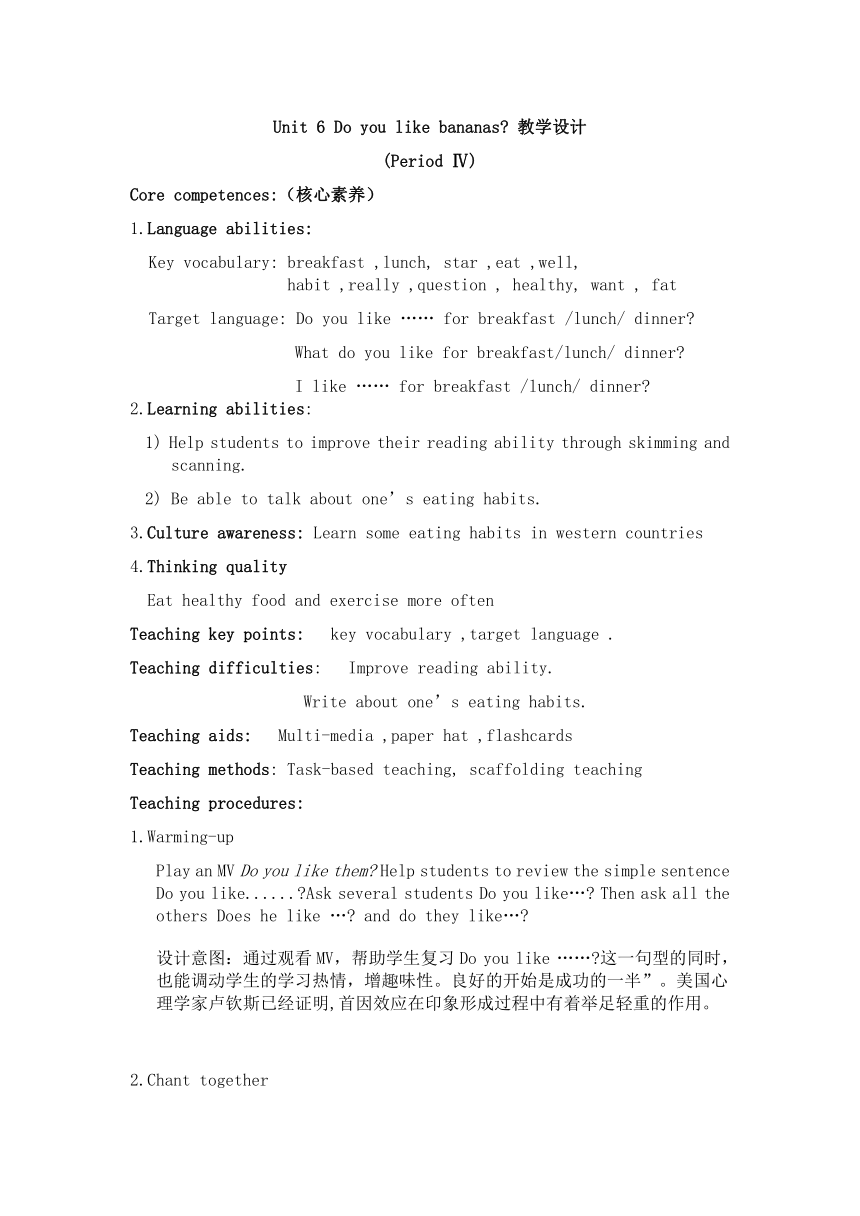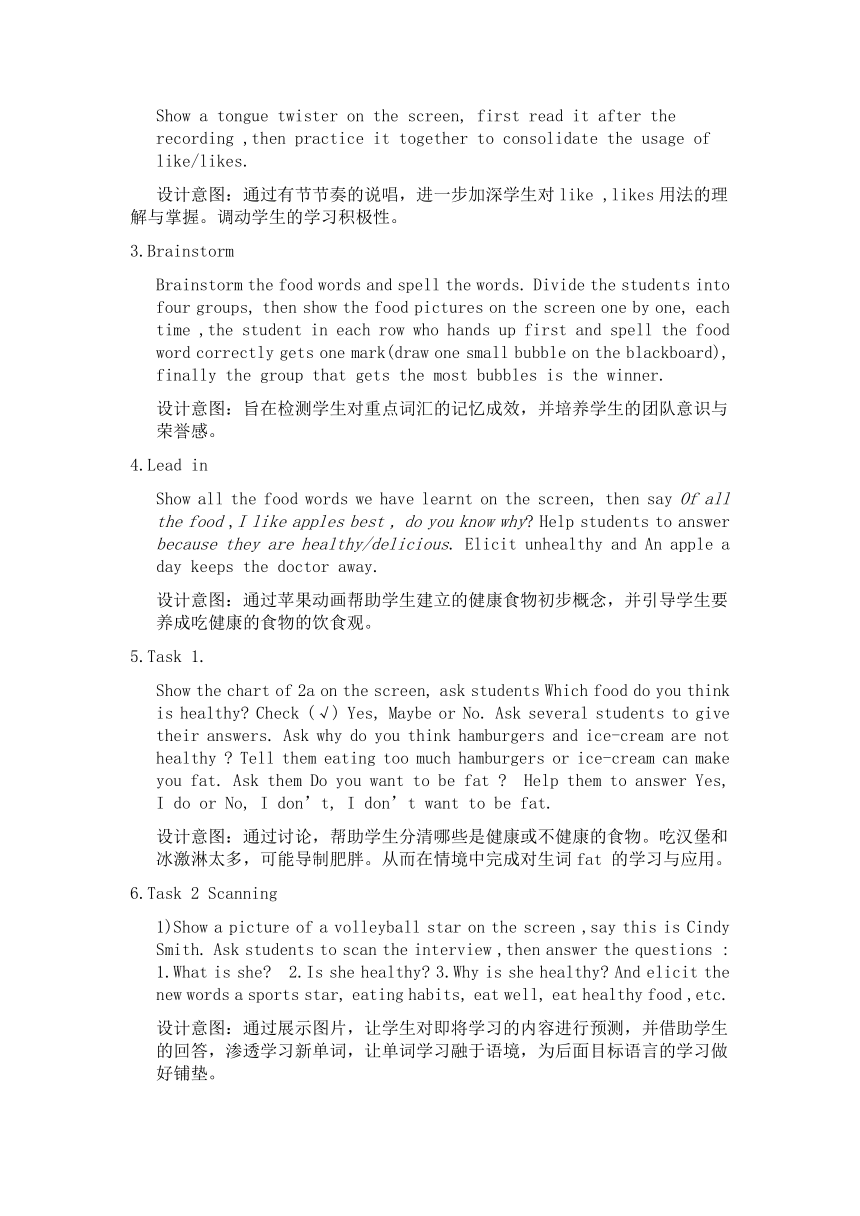人教版七年级上册Unit 6 Do you like bananas?SectionB 2a-3d Self check 教案
文档属性
| 名称 | 人教版七年级上册Unit 6 Do you like bananas?SectionB 2a-3d Self check 教案 |

|
|
| 格式 | doc | ||
| 文件大小 | 70.5KB | ||
| 资源类型 | 教案 | ||
| 版本资源 | 人教新目标(Go for it)版 | ||
| 科目 | 英语 | ||
| 更新时间 | 2022-11-10 09:06:00 | ||
图片预览


文档简介
Unit 6 Do you like bananas 教学设计
(Period Ⅳ)
Core competences:(核心素养)
1.Language abilities:
Key vocabulary: breakfast ,lunch, star ,eat ,well, habit ,really ,question , healthy, want , fat
Target language: Do you like …… for breakfast /lunch/ dinner
What do you like for breakfast/lunch/ dinner
I like …… for breakfast /lunch/ dinner
2.Learning abilities:
1) Help students to improve their reading ability through skimming and scanning.
2) Be able to talk about one’s eating habits.
3.Culture awareness: Learn some eating habits in western countries
4.Thinking quality
Eat healthy food and exercise more often
Teaching key points: key vocabulary ,target language .
Teaching difficulties: Improve reading ability.
Write about one’s eating habits.
Teaching aids: Multi-media ,paper hat ,flashcards
Teaching methods: Task-based teaching, scaffolding teaching
Teaching procedures:
1.Warming-up
Play an MV Do you like them Help students to review the simple sentence Do you like...... Ask several students Do you like… Then ask all the others Does he like … and do they like…
设计意图:通过观看MV,帮助学生复习Do you like …… 这一句型的同时,也能调动学生的学习热情,增趣味性。良好的开始是成功的一半”。美国心理学家卢钦斯已经证明,首因效应在印象形成过程中有着举足轻重的作用。
2.Chant together
Show a tongue twister on the screen, first read it after the recording ,then practice it together to consolidate the usage of like/likes.
设计意图:通过有节节奏的说唱,进一步加深学生对like ,likes用法的理解与掌握。调动学生的学习积极性。
3.Brainstorm
Brainstorm the food words and spell the words. Divide the students into four groups, then show the food pictures on the screen one by one, each time ,the student in each row who hands up first and spell the food word correctly gets one mark(draw one small bubble on the blackboard), finally the group that gets the most bubbles is the winner.
设计意图:旨在检测学生对重点词汇的记忆成效,并培养学生的团队意识与荣誉感。
4.Lead in
Show all the food words we have learnt on the screen, then say Of all the food ,I like apples best , do you know why Help students to answer because they are healthy/delicious. Elicit unhealthy and An apple a day keeps the doctor away.
设计意图:通过苹果动画帮助学生建立的健康食物初步概念,并引导学生要养成吃健康的食物的饮食观。
5.Task 1.
Show the chart of 2a on the screen, ask students Which food do you think is healthy Check (√) Yes, Maybe or No. Ask several students to give their answers. Ask why do you think hamburgers and ice-cream are not healthy Tell them eating too much hamburgers or ice-cream can make you fat. Ask them Do you want to be fat Help them to answer Yes, I do or No, I don’t, I don’t want to be fat.
设计意图:通过讨论,帮助学生分清哪些是健康或不健康的食物。吃汉堡和冰激淋太多,可能导制肥胖。从而在情境中完成对生词fat 的学习与应用。
6.Task 2 Scanning
1)Show a picture of a volleyball star on the screen ,say this is Cindy Smith. Ask students to scan the interview ,then answer the questions : 1.What is she 2.Is she healthy 3.Why is she healthy And elicit the new words a sports star, eating habits, eat well, eat healthy food ,etc.
设计意图:通过展示图片,让学生对即将学习的内容进行预测,并借助学生的回答,渗透学习新单词,让单词学习融于语境,为后面目标语言的学习做好铺垫。
2)Ask the students to scan the magazine article and circle the food words and underline the meals. Then check the answers. Tell them the article can be divided into four parts: breakfast , lunch , dinner, after dinner.
设计意图:通过scanning 和skimming 这两个环节,培养学生快速寻找信息的阅读速度和阅读技巧。并引导学生通过文中餐点时间将文章分段。明析文章的写作层次。
7.Task 3 Filling the charts
Ask the students to read conversation again, and try to fill the charts about different parts , eg.(Chart 1 breakfast)
Tell them happy face means like and sad face means dislike/don’t like. Ask one student to fill in the chart. Then just look at the chart and try to retell the breakfast part of the article using sentences like For breakfast, I like ……, I don’t like ……. I think it’s ……
Repeat the same step to lunch, dinner and after dinner.
设计意图:通过完成表格,培养学生精读细读习能力,在学生完成表格后,让学生只看表格,运用目标语言来复述本段内容。既加深了学生对课文的理解,也训练了学生运用已知信息组织语言的思维品质和口语表达能力。
8.After-reading
Emphasis three important sentences in the coversation: Do you like …… for breakfast /lunch/ dinner What do you like for breakfast/lunch/ dinner I like …… for breakfast /lunch/ dinner Students have one minute to practice the three sentences with their partner..
设计意图:加强学生对目标语言的识记,通过与同伴练习,提升学生运用目标语言的熟练度。为下面的口头交际及写作练习进行铺垫。
9.Practice
Tell students ,Suppose(假设) you are a working(工作)for our school dining hall(餐厅),you want to know what students like for breakfast /lunch/dinner. Ask one or two students to interview some students using the target language.
设计意图:通过情境的创设,放手让学生进行生生互动,既训练了学生的语言能力,也训练了学生的交际能力和思维品质。
10.Game time
Student A choose one flashcard with a food word on it, then stick it to the paper hat, help student B who stands back to Student A put on the hat so that the other students can see the food word, then tell Student B Student A’s favorite food word for breakfast is on the hat,you should ask Student A Do you like …… for breakfast You only have three times to see if you can get the right answer. If Student B can’t guess the right answer, he/she can ask Student A a fourth time What do you like for breakfast Student A tells Student B I like …… for breakfast. Ask three pairs to play the game to see who can guess rightly first.
设计意图:希望通过游戏能进一步提高学生运用英语的思维品质和表达欲望,培养学习英语的兴趣。
11.Writing
Give students 3 minutes to write their own eating habits,then ask three students to report their eating habits in front of the class.
设计意图:培养学生的文化意识,帮助学生学以致用,运用以上环节的循序渐进所输入的知识以及所积累的词汇进行有效输出,非常符合学生的认知结构,让学生当堂报告或脱稿谈论自己的饮食习惯,既能锻炼写也能锻炼说,也能培养学生的自信心。
(Period Ⅳ)
Core competences:(核心素养)
1.Language abilities:
Key vocabulary: breakfast ,lunch, star ,eat ,well, habit ,really ,question , healthy, want , fat
Target language: Do you like …… for breakfast /lunch/ dinner
What do you like for breakfast/lunch/ dinner
I like …… for breakfast /lunch/ dinner
2.Learning abilities:
1) Help students to improve their reading ability through skimming and scanning.
2) Be able to talk about one’s eating habits.
3.Culture awareness: Learn some eating habits in western countries
4.Thinking quality
Eat healthy food and exercise more often
Teaching key points: key vocabulary ,target language .
Teaching difficulties: Improve reading ability.
Write about one’s eating habits.
Teaching aids: Multi-media ,paper hat ,flashcards
Teaching methods: Task-based teaching, scaffolding teaching
Teaching procedures:
1.Warming-up
Play an MV Do you like them Help students to review the simple sentence Do you like...... Ask several students Do you like… Then ask all the others Does he like … and do they like…
设计意图:通过观看MV,帮助学生复习Do you like …… 这一句型的同时,也能调动学生的学习热情,增趣味性。良好的开始是成功的一半”。美国心理学家卢钦斯已经证明,首因效应在印象形成过程中有着举足轻重的作用。
2.Chant together
Show a tongue twister on the screen, first read it after the recording ,then practice it together to consolidate the usage of like/likes.
设计意图:通过有节节奏的说唱,进一步加深学生对like ,likes用法的理解与掌握。调动学生的学习积极性。
3.Brainstorm
Brainstorm the food words and spell the words. Divide the students into four groups, then show the food pictures on the screen one by one, each time ,the student in each row who hands up first and spell the food word correctly gets one mark(draw one small bubble on the blackboard), finally the group that gets the most bubbles is the winner.
设计意图:旨在检测学生对重点词汇的记忆成效,并培养学生的团队意识与荣誉感。
4.Lead in
Show all the food words we have learnt on the screen, then say Of all the food ,I like apples best , do you know why Help students to answer because they are healthy/delicious. Elicit unhealthy and An apple a day keeps the doctor away.
设计意图:通过苹果动画帮助学生建立的健康食物初步概念,并引导学生要养成吃健康的食物的饮食观。
5.Task 1.
Show the chart of 2a on the screen, ask students Which food do you think is healthy Check (√) Yes, Maybe or No. Ask several students to give their answers. Ask why do you think hamburgers and ice-cream are not healthy Tell them eating too much hamburgers or ice-cream can make you fat. Ask them Do you want to be fat Help them to answer Yes, I do or No, I don’t, I don’t want to be fat.
设计意图:通过讨论,帮助学生分清哪些是健康或不健康的食物。吃汉堡和冰激淋太多,可能导制肥胖。从而在情境中完成对生词fat 的学习与应用。
6.Task 2 Scanning
1)Show a picture of a volleyball star on the screen ,say this is Cindy Smith. Ask students to scan the interview ,then answer the questions : 1.What is she 2.Is she healthy 3.Why is she healthy And elicit the new words a sports star, eating habits, eat well, eat healthy food ,etc.
设计意图:通过展示图片,让学生对即将学习的内容进行预测,并借助学生的回答,渗透学习新单词,让单词学习融于语境,为后面目标语言的学习做好铺垫。
2)Ask the students to scan the magazine article and circle the food words and underline the meals. Then check the answers. Tell them the article can be divided into four parts: breakfast , lunch , dinner, after dinner.
设计意图:通过scanning 和skimming 这两个环节,培养学生快速寻找信息的阅读速度和阅读技巧。并引导学生通过文中餐点时间将文章分段。明析文章的写作层次。
7.Task 3 Filling the charts
Ask the students to read conversation again, and try to fill the charts about different parts , eg.(Chart 1 breakfast)
Tell them happy face means like and sad face means dislike/don’t like. Ask one student to fill in the chart. Then just look at the chart and try to retell the breakfast part of the article using sentences like For breakfast, I like ……, I don’t like ……. I think it’s ……
Repeat the same step to lunch, dinner and after dinner.
设计意图:通过完成表格,培养学生精读细读习能力,在学生完成表格后,让学生只看表格,运用目标语言来复述本段内容。既加深了学生对课文的理解,也训练了学生运用已知信息组织语言的思维品质和口语表达能力。
8.After-reading
Emphasis three important sentences in the coversation: Do you like …… for breakfast /lunch/ dinner What do you like for breakfast/lunch/ dinner I like …… for breakfast /lunch/ dinner Students have one minute to practice the three sentences with their partner..
设计意图:加强学生对目标语言的识记,通过与同伴练习,提升学生运用目标语言的熟练度。为下面的口头交际及写作练习进行铺垫。
9.Practice
Tell students ,Suppose(假设) you are a working(工作)for our school dining hall(餐厅),you want to know what students like for breakfast /lunch/dinner. Ask one or two students to interview some students using the target language.
设计意图:通过情境的创设,放手让学生进行生生互动,既训练了学生的语言能力,也训练了学生的交际能力和思维品质。
10.Game time
Student A choose one flashcard with a food word on it, then stick it to the paper hat, help student B who stands back to Student A put on the hat so that the other students can see the food word, then tell Student B Student A’s favorite food word for breakfast is on the hat,you should ask Student A Do you like …… for breakfast You only have three times to see if you can get the right answer. If Student B can’t guess the right answer, he/she can ask Student A a fourth time What do you like for breakfast Student A tells Student B I like …… for breakfast. Ask three pairs to play the game to see who can guess rightly first.
设计意图:希望通过游戏能进一步提高学生运用英语的思维品质和表达欲望,培养学习英语的兴趣。
11.Writing
Give students 3 minutes to write their own eating habits,then ask three students to report their eating habits in front of the class.
设计意图:培养学生的文化意识,帮助学生学以致用,运用以上环节的循序渐进所输入的知识以及所积累的词汇进行有效输出,非常符合学生的认知结构,让学生当堂报告或脱稿谈论自己的饮食习惯,既能锻炼写也能锻炼说,也能培养学生的自信心。
同课章节目录
- starters 预备篇(2012秋审查)
- Unit 1 Good morning !
- Unit 2 What’s this in English?
- Unit 3 What color is it ?
- Unit 1 My name's Gina.
- Section A
- Section B
- Unit 2 This is my sister.
- Section A
- Section B
- Unit 3 Is this your pencil?
- Section A
- Section B
- Unit 4 Where's my schoolbag?
- Section A
- Section B
- Unit 5 Do you have a soccer ball?
- Section A
- Section B
- Unit 6 Do you like bananas?
- Section A
- Section B
- Unit 7 How much are these socks?
- Section A
- Section B
- Unit 8 When is your birthday?
- Section A
- Section B
- Unit 9 My favorite subject is science.
- Section A
- Section B
